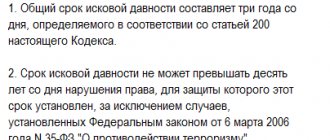To enforce the collection of debt from the debtor, it is important to present a writ of execution for execution on time. We will consider in more detail how to restore the deadline for presenting the writ and appeal the refusal to restore the deadline, how many times it can be filed, how to restore the deadline for presenting the writ and appeal the refusal to restore the deadline.
ATTENTION : our lawyer for enforcement proceedings on the side of the claimant or debtor will help you in the matter of presenting a writ of execution to the bank, bailiff, directly to the debtor’s work: professionally, on favorable terms and on time. Call today!
Deadline for submitting a writ of execution for execution
In accordance with Art. 21 of the Law on Enforcement Proceedings, a writ of execution, as a general rule, can be presented for execution within 3 years. The specified period begins to count from the day when the judicial act came into force.
If a writ of execution is issued in response to demands for the return of a child who has been illegally transferred or detained in the Russian Federation, then it must be presented for execution within 1 year from the date the court decision enters into force.
In the event that an arbitration court has restored the deadline for presenting a writ of execution for execution, for which the deadline was missed and which was issued on the basis of a decision of the arbitration court, the writ may be presented within 3 months from the date the court made a ruling to restore the deadline.
If the execution is issued for the collection of periodic payments, then it can be presented during the entire period for collecting payments, and within 3 years when the corresponding period for collecting payments has expired.
After what time does a writ of execution lose its force?
He does not lose anything at all, of course, provided that it is submitted on time and was accepted by the bailiff. The logical conclusion of this procedure is the opening of proceedings and the issuance of the corresponding resolution. After this comes the stage of collecting the awarded amount of money. The bailiff must ensure this.
Federal Law No. 229 strictly regulates the deadlines:
If the statute of limitations for the writ of execution has passed, and the claimant never bothered to complete the entire procedure correctly and on time, he may finally lose the opportunity to receive the money that was collected by the judge.
Alexander lent it to his good friend Ivan. He had temporary financial problems, and he asked Alexander for a loan of 70,000 rubles for a couple of months. Despite the friendly relationship, everything was formalized in writing in the form of a receipt. But three months later, Ivan’s financial situation has not improved. After waiting some more time, the creditor filed a lawsuit. The writ of execution was received, but Alexander never presented it to the joint venture. Ivan tearfully begged him not to do this and assured him that he would give everything back from his next salary. So a year passed, then another, then Alexander himself had problems, he became seriously ill, and there was no time for that. When he finally got together in the joint venture, the time was lost.
In such a situation, the bailiff has no choice but to issue a refusal order, because the deadline for presenting the document has expired. True, the lender has a chance to restore it. It is quite possible that this will be done through the court if the judge admits that the three-year period was missed due to extremely extenuating circumstances.
Break of the period for presentation of the writ of execution
The deadline for presenting a writ of execution for execution may be interrupted in certain Art. 22 of the Law on Enforcement Proceedings in cases, namely:
- if the executive is presented for execution
- if the debtor partially fulfilled the execution
After the break in the deadline has ended, a new deadline for presenting the enforcement order begins to run. In this case, the period that expired before the interruption does not count towards the new period.
If the writ of execution was returned to the claimant for the reason that it is impossible to execute, then the period for presentation for execution begins to count from the date of return.
In a situation where the enforcement was recalled by the claimant or he committed actions that prevented execution, and therefore the execution was completed, then the period from the date of presentation for execution to the day the execution ends is subtracted from the period for presenting the enforcement for execution.
In the event of a postponement or suspension of the execution of a judicial act or an act of another body, the period for presentation for execution is resumed from the day the execution is resumed.
How the FSSP collects debts from individuals
If the court has made a decision to collect a debt from an individual, then the corresponding document will be sent to the territorial department of bailiffs at the debtor’s place of residence. After this, the FSSP will notify the individual with a summons.
There is another way to collect a tax from an individual. The collector himself can contact the place of registration of the person who owes him and submit an application to initiate enforcement proceedings by the FSSP. In this case, you will need to find out his place of work and the banking institution where the debtor has an account.
A few days later, the bailiffs will open enforcement proceedings, and the process will be put into action. This gives a start to the forced collection of funds - from the seizure of accounts to the sale of property.
Important! Without a court decision, the FSSP does not have the right to begin enforcement proceedings. According to the law, only a court document allows the opening of an individual entrepreneur.
How many times can a writ of execution be submitted for production?
Taking into account the fact that enforcement proceedings can be terminated by bailiffs, including, unreasonably, the enforcement officer can return, the question arises, how many times can a writ of execution be submitted to the proceedings? The answer to this question is very simple: as much as you like, as long as the deadline for presentation for execution has not expired.
When re-submitting a writ of execution for proceedings, take into account the deadlines when the presentation deadline is interrupted if you are worried that the deadline has been missed.
It is better to present the writ of execution again, if necessary, without thinking about the timing of presentation, so as not to accidentally miss it. If the bailiff suddenly returns the writ, considering that the deadline for presentation has been missed, then you need to look at the first time you presented the writ and the subsequent times when the deadline was interrupted, and then appeal the bailiff’s actions.
What will happen to the deadlines after the court order is cancelled?
If the debtor manages to file objections within 10 days, then the court order simply will not enter into force. In this case, there is no need to take into account the limitation period for presentation for execution. If the order is canceled due to a cassation appeal, all procedural deadlines for execution are also automatically canceled.
If the claimant exercises his right and files a claim, then instead of an order he will receive a writ of execution. You are also given 3 years to present this document. But the period will begin to run from the date the court decision enters into force.
Restoring the deadline for submitting a writ of execution for execution
If you did happen to miss the deadline for presenting the writ for execution, you don’t need to get upset ahead of time, because you can try to restore this deadline.
To restore the missed deadline in question, you must apply to the court.
At the same time, the Arbitration Procedure Code of the Russian Federation and the Code of Arbitration Procedures of the Russian Federation simply state that the claimant may ask for the restoration of the term, and the Code of Civil Procedure of the Russian Federation states that the term can be restored by the court if the reasons for missing it are considered valid. In any case, the issue of restoring the deadline in order to present the execution for execution will be decided by each judge individually, and the chances of restoring the deadline are greater in cases where it is missed for valid reasons that are duly confirmed.
USEFUL : for more information about the restoration of procedural deadlines, follow the link on the website of the Law Office “Katsailidi and Partners”, Yekaterinburg, as well as in the video
Duration of enforcement proceedings
The next question is how long does enforcement proceedings last for bailiffs? According to Art. 36 Federal Law No. 229-FZ, the FSSP employee is given two months to execute the court decision.
In practice, cases where debt repayment occurs in such a short time are extremely rare. At the request of the claimant, the bailiff may extend the term, for which he will issue a separate ruling - for example, if no answers have been received from the state. authorities about the debtor's property, if the person is wanted, if an auction is being prepared.
Enforcement proceedings may also be suspended:
- by a court decision - for example, if the debtor challenges the collection on newly discovered grounds or when bankruptcy is declared in the Arbitration Court;
- in the event of the death of the debtor or his recognition as incompetent - until the date of identification of heirs or guardians;
- at the request of the debtor himself - in case of his illness or conscription into the army.
If the bailiff checked the property and income of an individual. person, and came to the conclusion that there is nothing to collect, the IL is returned to the collector. Resumption of enforcement proceedings occurs at any time in accordance with a repeated application by the creditor. As already noted, the basis for its complete termination is the bankruptcy of the debtor.
Appeal against refusal to restore the deadline for submitting a sheet for execution
If the court refuses to restore the deadline to file the writ for execution, then it is worth taking the opportunity to appeal the corresponding court ruling on the refusal. When appealing, you must indicate why the court's decision to refuse is illegal, what violations were committed by the court when considering the application, and what was not taken into account by the court.
The court's ruling on refusal must indicate the period for appeal. The appeal period may be 10 days or 15 days, so you should study the provisions of the ruling on the appeal period and do not miss this period.
To appeal a refusal to restore the deadline:
- prepare a complaint (private complaint) to a higher court
- send a copy of the complaint to other participants in the process
- file a complaint with the necessary attachments to the court of first instance
- wait for the decision on the complaint from a higher court
Summary
1. In connection with the new laws on the limitation period, when the writ of execution is presented again to the bailiffs, the previous period is deducted only if the claimant himself revoked the writ of execution? Or if the bailiff completed the proceedings under Article 46, then this period is also taken into account?
1.1. Hello Nikolay. There is no new statute of limitations. In this regard, the essence of the issue is not clear.
1.2. What kind of new law is this? Give me some milk? Thank you).
2. Is it legal to present a writ of execution again if the statute of limitations has expired and what petition should I write to the bailiffs so that they stop the enforcement proceedings?
2.1. A writ of execution has no statute of limitations; the claimant has the right to present the writ of execution for execution an unlimited number of times.
2.2. It is necessary to appeal the decision to initiate enforcement proceedings in court in accordance with the CAS RF procedure.
2.3. Good afternoon. Read the following articles from the Federal Law “On Enforcement Proceedings”. Perhaps in your case the statute of limitations has not expired, since there was a break. It’s not just that you mentioned the repeated presentation of the writ of execution.
Article 21. Time limits for presenting writs of execution for execution
1. Writs of execution issued on the basis of judicial acts, with the exception of writs of execution specified in parts 2, 4 and 7 of this article, can be presented for execution within three years from the date the judicial act enters into legal force. Writs of execution containing demands for the return, on the basis of an international treaty of the Russian Federation, of a child illegally transferred to the Russian Federation or detained in the Russian Federation, are presented for execution within one year from the date of entry into force of the judicial act. (as amended by Federal Laws dated 05.05.2014 N 126-FZ, dated 03/08/2015 N 57-FZ) (see text in the previous edition) 2. Writs of execution issued on the basis of judicial acts of arbitration courts, according to which the arbitration court has reinstated a missed deadline for presenting a writ of execution for execution may be presented for execution within three months from the date the court issues a ruling to restore the missed deadline. 3. Court orders may be submitted for execution within three years from the date of their issue. 4. Enforcement documents containing demands for the collection of periodic payments may be presented for execution during the entire period for which payments are awarded, as well as within three years after the end of this period. 5. Certificates issued by labor dispute commissions may be presented for execution within three months from the date of their issue. 6. Acts of the bodies exercising control functions drawn up in the established manner on the collection of funds with the attachment of documents containing marks of banks or other credit organizations in which settlement and other accounts of the debtor are opened, on complete or partial failure to fulfill the requirements of these bodies due to the lack of funds in the debtor's accounts sufficient to satisfy these requirements may be presented for execution within six months from the date of their return by the bank or other credit institution. 6.1. Acts of bodies exercising control functions drawn up in the established manner on the collection of funds without attaching the documents specified in Part 6 of this article can be presented for execution within six months from the date of their issuance. (Part 6.1 introduced by Federal Law No. 358-FZ of December 21, 2013) 7. Judicial acts, acts of other bodies and officials in cases of administrative offenses can be presented for execution within two years from the date of their entry into legal force. (as amended by Federal Law No. 71-FZ of April 21, 2011) (see the text in the previous edition) 8. The deadlines for presenting for execution executive documents not specified in this article are established in accordance with federal laws. 9. If a federal law or a judicial act, an act of another body or official sets a deadline for the debtor to fulfill the requirements contained in an executive document, or is granted a deferment or installment plan for the execution of these requirements, the duration of the period for submitting such an executive document (excluding the executive document on collection of a fine imposed as punishment for committing a crime) begins after the expiration date of the period established for the debtor to fulfill the requirements contained in the writ of execution, granting him a deferment or installment plan for the fulfillment of these requirements.
Article 22. Break of the deadline for presenting a writ of execution for execution
Article 128. The procedure for challenging decisions of officials of the bailiff service, their actions (inaction)
1. Resolutions of an official of the bailiff service, his actions (inaction) regarding the execution of a writ of execution may be challenged in an arbitration court or a court of general jurisdiction in the manner established by the procedural legislation of the Russian Federation, taking into account the specifics established by this Federal Law. (as amended by Federal Law dated December 30, 2015 N 425-FZ) (see text in the previous edition) 2. An application to challenge the decision of an official of the bailiff service, his actions (inaction) is submitted to the arbitration court in the following cases: 1) execution a writ of execution issued by an arbitration court; 2) fulfillment of the requirements contained in the executive documents specified in paragraphs 5 and 6 of part 1 of Article 12 of this Federal Law in relation to an organization or citizen carrying out business activities without forming a legal entity; 3) execution of the order of the bailiff, issued in accordance with Part 6 of Article 30 of this Federal Law, if the debtor is an organization or citizen engaged in business activities without forming a legal entity, and enforcement proceedings were initiated in connection with its business activities; 4) in other cases established by the arbitration procedural legislation of the Russian Federation. 3. In cases not specified in part 2 of this article, the application is submitted to a court of general jurisdiction. 4. The consideration of the application by the court is carried out within ten days according to the rules established by the procedural legislation of the Russian Federation, taking into account the specifics established by this Federal Law.
This is interesting: LPR Bank pensions for what date
3. I received a protocol on the completion of enforcement proceedings on the writ of execution. Question 1: is it possible to re-submit a writ of execution to the bailiffs? Question 2: will the deadline for presenting a writ of execution be calculated anew? Again, 3 years after the issuance of the protocol on the completion of enforcement proceedings?
3.1. 1. possible; 2 again 3 years; also see on what grounds the production was returned;
Federal Law of 02.10.2007 N 229-FZ (as amended on 03.08.2018) “On Enforcement Proceedings” (as amended and additionally, entered into force on 03.09.2018) “” Article 46. Return of the writ of execution to the claimant after initiation of enforcement proceedings
3.2. Hello, you can resubmit the writ of execution no earlier than six months from the date of the decision to end the enforcement proceedings and return the writ of execution to the claimant, in accordance with Art. 21, 46 Federal Law "On enforcement proceedings" The period of three years also remains.
3.3. If the bailiff graduated from the IP under clause 1 of Part 1 of Article 46 of the IP, then the period of 3 years is not recalculated. The time spent in production is not taken into account. document from the bailiffs. If according to clause 3, part 1. Article 46, then the period for presentation starts again from the date of termination of the IP by the bailiff. You can reapply at least the next day after graduation. If according to clause 4 part 1. Article 46, then the period for presentation starts again from the date of termination of the IP by the bailiff. Submission isp. document again only 6 months after the end of the IP.
4. The statute of limitations for re-submitting a writ of execution for collection is three years from the date of the decision to terminate the IP (Clause 4, Part 1, Article 46) and the return of the IP to the recoverer. And if, after issuing a decision to end the IP, the bailiff did not return the IL (as the creditor assures). So there was no statute of limitations? Thank you in advance.
4.1. You should not trust the lender. I recommend that you contact the bailiff service and ask them for copies of documents confirming the sending and receipt of the writ of execution by the claimant (the writ of execution is handed over to the claimant personally against signature or sent by registered mail with notification). In accordance with the Federal Law of October 2, 2007 No. 229-FZ “On Enforcement Proceedings,” a resolution is issued on the termination of enforcement proceedings. Copies of the bailiff's decision on the completion of enforcement proceedings no later than the day following the day of its issuance are sent to the claimant and the debtor. If the claimant was not notified of the time and place of the action (did not receive a copy of the resolution on completion), then the bailiff’s decision on the termination of enforcement proceedings can be appealed within ten days from the day when this person learned or should have known about making a decision. Thus, the period will be calculated from the date of adoption of the resolution on the completion of enforcement proceedings, and not from the moment the claimant receives the writ of execution.
5. From what time does the statute of limitations for re-submitting a writ of execution for collection begin? Three years from the date of the decision to terminate the IP (clause 4, part 1, Article 46) or from the moment the IP was returned to the claimant? And if after the end of the IP the bailiff did not return the IL (as the creditor assures). So there was no statute of limitations? Thank you in advance.
5.1. Good day.
In accordance with Art. 22 Federal Law “On Enforcement Proceedings”:
1. The deadline for presenting a writ of execution for execution is interrupted: 1) by presenting a writ of execution for execution; 2) partial execution of the writ of execution by the debtor. 2. After the break, the period for presenting the writ of execution for execution is resumed. The time elapsed before the deadline is interrupted does not count towards the new deadline. 3. If the writ of execution is returned to the claimant due to the impossibility of its execution, the period for presenting the writ of execution for execution is calculated from the day the writ of execution is returned to the claimant. 4. If the execution of a judicial act, an act of another body or official has been delayed or suspended, then the period for submitting a writ of execution for execution shall be resumed from the day the execution of the judicial act, act of another body or official is resumed. 5. If the debtor is granted an installment plan for fulfilling the requirements contained in the writ of execution, such a writ of execution may be presented for execution without observing the rules established by Part 9 of Article 21 of this Federal Law, if the debtor has failed to fulfill part of the requirements contained in the writ of execution more than twice. executive document according to which he was granted an installment plan. 6. The effect of parts 1 - 4 of this article does not apply to judicial acts, acts of other bodies and officials in cases of administrative offenses.
6. A writ of execution was sent to the bailiff to collect the amount of the debt. After some time, the writ of execution was returned due to the debtor’s lack of money and property. Is it possible to submit it again, and what is the deadline for submitting a writ of execution for execution?
Federal Law of October 2, 2007 N 229-FZ (as amended on April 23, 2018) “On Enforcement Proceedings” (as amended and supplemented, entered into force on June 1, 2018) Article 46. Return of the writ of execution to the claimant after the initiation of the writ of execution production
5. If the executive document is returned to the claimant in accordance with paragraph 4 of part 1 of this article, the claimant has the right to re-submit for execution the enforcement documents specified in parts 1, 3, 4 and 7 of Article 21 of this Federal Law, no earlier than six months from the date of the decision on the completion of enforcement proceedings
and on the return of the writ of execution to the recoverer, and other writs of execution no earlier than two months or before the expiration of the specified period if the recoverer provides information about a change in the debtor’s property status.
6.2. Good evening. If the enforcement proceedings are completed due to the debtor’s lack of funds, then the sheet can be presented again no earlier than 6 months from the date of completion of the enforcement proceedings. The total period for presenting a writ for collection is 3 years from the date of its issuance by the court.
7. Individual entrepreneur closed on December 13, 2014, article 46, part 1, clause 4. Writ of execution dated December 20, 2011. Debt for road accident insurance payment. When does the statute of limitations expire and is it possible to re-present the IL for execution?
7.1. Hello, There are no statutes of limitations for collecting debt by court decision, but the writ of execution must be presented for execution within three years, or it must be renewed for a new term. I wish you good luck and all the best!
7.2. A writ of execution can be presented for execution within three years from the date of its return to the claimant; after three years, upon presentation of the writ by the bailiff, acceptance for execution will be refused.
What should the claimant do?
If the sheet is returned, this does not mean that the claimant loses the right to receive the award. Please make claims after six months, it is not prohibited. Often, an ordinary person does not have legal knowledge in the field of enforcement proceedings. Bailiffs take advantage of the legal illiteracy of the population and violate the law. A common situation is that the bailiff did not take the necessary measures to execute the writ of execution and returned the writ of execution. Before we continue, a small digression.
The plaintiff is given the right to apply for interim measures. This further protects the rights of the litigant. In this case, the opposing party is deprived of the opportunity to hide property that could be foreclosed on in the future. An interim measure does not imply the sale of property, but serves as a tool for preserving property until the consideration of the claims of a party to the lawsuit. Based on the results of consideration of the application for an interim measure, the court issues or refuses to issue a writ of execution. Executive documents on seizure (interim measures) are subject to immediate execution. The bailiff has the right to terminate enforcement actions on the same grounds as any executive document. The legal requirements of an official are mandatory for all participants, read more.





